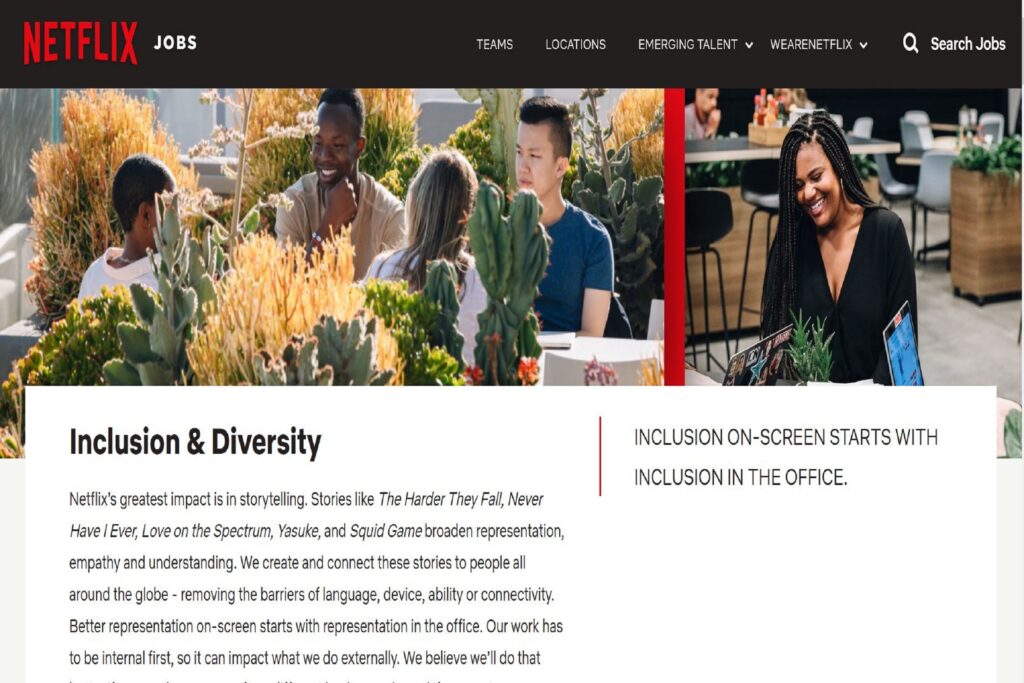The centre of my PhD project is organisational communication about diversity. Usually, organisations communicate their value of diversity in so-called diversity statements. For example, this is a statement from Netflix:
“Netflix’s greatest impact is in storytelling. Stories like The Harder They Fall, Never Have I Ever, Love on the Spectrum, Yasuke, and Squid Game broaden representation, empathy and understanding. We create and connect these stories to people all around the globe – removing the barriers of language, device, ability or connectivity. Better representation on-screen starts with representation in the office. Our work has to be internal first, so it can impact what we do externally. We believe we’ll do that better if our employees come from different backgrounds, and if we create an environment of inclusion and belonging for them.”
With these diversity statements, organisations strive to build a more diverse workforce by attracting members from underrepresented groups. There are different options to make a message more persuasive. One way is to focus on the content of the message. Another path, that I decided to take, is to focus on subtler cues.
Emotions as Social Information Theory, proposed by Gerbert van Kleef, postulates that people use emotions expressed by others be it through facial expressions, tone of voice, bodily postures, and written or spoken words as a source of information that affects a recipient’s thoughts, attitudes, and/or behaviours. It might happen through two mechanisms: A cognitive or an affective one. Imagine that a person is passionately, using emotional words, telling you something that worries them. You might either think that it might be an important issue for them, since they are using a lot of emotional words (cognitive process) or you might start experiencing the emotion (e.g., joy or fear) that the person is showing or telling (affective process). Either process will affect your thoughts, attitudes, and/or behaviour. Thus, the more emotionally loaded the message, the more information it should provide to a reader. For our study, we assumed that diversity is a good thing. To test the prediction that positively emotionally loaded diversity statements would be better at convincing people that an organisation cares about diversity, I conducted three studies.
In the first study, I looked at diversity statements from 600 European organisations. Only 399 of those used some degree of positive emotionality in their diversity statements. To estimate the degree of positive emotionality, I used a linguistic computational tool, the Evaluative Lexicon, designed to quantify the valence, extremity, and degree of emotionality of the texts. The average levels of emotionality were quite low, however.
In the second study, 220 participants from the UK were recruited and asked to read an original diversity statement from the first study with either a high or a low level of positive emotionality. They were then asked to respond to the questions about their experienced emotions and attitudes toward the abstract organisation. Contrary to the predictions, participants’ attitudes toward the organisation were not significantly different after reading a diversity statement with either a high or a low level of positive emotionality. It is possible that positive emotionality was not pronounced enough to affect one’s attitude. Therefore, in the next study, a more controlled design was used.
In the third study, 815 participants from the UK were recruited. They were asked to read a modified diversity statement (from the first study). The diversity statements differed in their levels of positive emotionality: High, low, or no emotionality (all emotional words from the Evaluative Lexicon were omitted). The positive emotionality was also made more pronounced in high and low conditions by adding a few highly/lowly emotional words to the statement both in high and low emotional conditions. The results suggested that, indeed, respondents had more favourable attitudes toward the organisation after reading a highly emotional diversity statement than those who read a diversity statement with low or no positive emotionality. Notably, it happened by triggering positive emotions in the readers. In other words, readers experienced more positive emotions after reading a diversity statement with high positive emotionality, which in turn resulted in more favourable attitudes toward the organisation. However, there were no significant differences in attitudes among those who read a statement with low or no emotionality. It suggests that strong emotional cues are needed to evoke more favourable attitudes toward the organisation.
Overall, the conducted research suggests that most European organisations have not used the potential of positive emotionality in their diversity statements. Should they decide to implement them, strong emotional cues are to be used to increase the organisational attractiveness.
Further readings
- Dover, T. L., Kaiser, C. R., & Major, B. (2020). Mixed Signals: The Unintended Effects of Diversity Initiatives. Social Issues and Policy Review, 14(1), 152–181. https://doi.org/10.1111/sipr.12059
- Jansen, W. S., Kröger, C., Van der Toorn, J., & Ellemers, N. (2021). The right thing to do or the smart thing to do? How communicating moral or business motives for diversity affects the employment image of Dutch public and private sector organizations. Journal of Applied Social Psychology, 51(7), 746–759. https://doi.org/10.1111/jasp.12783
- van Kleef, G. A., & Côté, S. (2022). The Social Effects of Emotions. Annual Review of Psychology, 73(1), 629–658. https://doi.org/10.1146/annurev-psych-020821-0108
55

Making a good case for gender diversity — Pathbreaking organisational communication (Switzerland)
